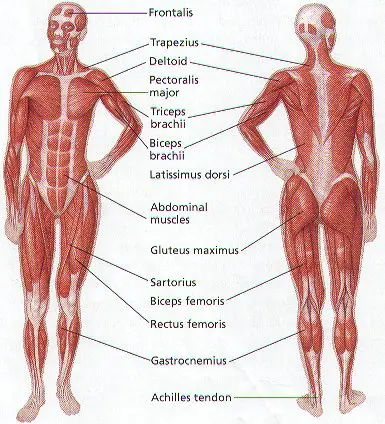The human body muscles are the main contractile tissues of the body involved in movement. They cause motion and produce a force that the body uses to move and manipulate the body. Each muscle also has its own blood supply, arteries, and veins, alongside its own nerve connections. Depending on the class of muscles we are looking at, or taken as a whole, the human body consists of around 640+ skeletal muscles.

The muscular system makes up nearly half the weight of the human body, this is why when we train we sometimes put on weight instead of losing it. We put on muscle weight.
The muscles provide the forces that enable the body to move. Muscles stretch across joints to link one bone with another and work in groups to respond to nerve impulses.
How many human muscles are there?
Table of Contents
There are nearly 650 skeletal muscles in the human body attaching to a bone and connecting a joint to enable us to move our limbs. There are also muscles that connect muscle to tissue and muscle to muscle.
Muscle material
Muscles are all made of the same material, a type of elastic tissue (sort of like the material in a rubber band). Thousands, or even tens of thousands, of small fibers, make up each muscle.
Types of muscle
There are three kinds of muscles we need to know about in the human body muscular system.
- Skeletal
- Smooth
- Cardiac
The most powerful muscles in the body are those that run along the spine. They maintain posture and provide the strength for lifting and pushing.
Skeletal muscle
Firstly there is the skeletal muscle, which is used for locomotion and skeletal movement. These muscles are often anchored by Tendons. A tendon is simply fibrous connective tissue, from the muscles to the bone elements. A Ligament is often found in the joints of the body, and are connective fibrous tissues from bone to bone. The gluteal muscles are some of the largest in the human body and are classed as a skeletal muscle because they help locomotion of the thighs during ambulation.
- There are nearly 650 skeletal muscles in the human body!
- Skeletal muscles are attached to the skeleton
- They work in pairs: one muscle moves the bone in one direction and the other moves it back again
- Skeletal muscles are voluntary muscles – in other words, we think about what movements we want to make (at least, usually!) and send messages via our nervous system to tell the appropriate muscle(s) to contract.
- Muscle contractions can be short, single contractions or longer ones.
Smooth muscle
The second type of muscle is Smooth Muscle. The smooth muscles are often found within the organs and structures of organs. These movements tend to be subconscious and help in the normal regulation of the human body.
- Smooth muscle is found in our internal organs: in our digestive system, our blood vessels, our bladder, our respiratory organs and, in a female, the uterus.
- Smooth muscle can stretch and maintain tension over extended periods
- Smooth muscles are involuntary muscles – in other words, we do not have to think about contracting them because they are controlled automatically by the nervous system. It would be pretty inconvenient if we had to think about digesting our food, for example!
Cardiac muscle
The third type of muscle is the Cardiac Muscle. The cardiac muscles are similar to the skeletal muscles. However, they are subconscious as the heart beats at a fast and steady rate.
- As the name should tell you, cardiac muscle is found only in the heart.
- It can stretch, just like smooth muscle, and contract like skeletal muscle.
- It is a twitch muscle – it only does short single contractions
- Like smooth muscle, cardiac muscle is involuntary. It’d be rather dangerous if it were voluntary – we could stop our heart beating any time we wanted!
The neck muscles and massive triangular muscles of the back stabilize the head and shoulders and permit a range of complex movements. The most powerful muscles in the body and those that run along the spine. They maintain posture and provide the strength for lifting and pushing.
The face muscles control a wide range of movements and are especially complex around the mouth and eyes.
Muscle Structure
Our muscle structure consists of densely packed groups of elongated cells known as muscle fibers.
- Skeletal muscle is composed of bundles of long striated fibers.
- Smooth muscle which is found in the walls of internal organs such as intestines is made of short spindle-shaped fibers packed together in layers.
- Cardiac muscle found only in the heart has short interconnecting fibers.
- These fibers are held together by fibrous connective tissue.
- Capillaries penetrate this tissue to keep the muscles supplied with oxygen and nutrients that are needed to fuel contraction.
- In a relaxed muscle, the thick and thin threads within a muscle fiber overlap a little.
- When a muscle contracts, the thick filaments slide further in between the thin filaments like interlacing fingers. This action shortens the entire fiber.
